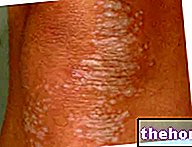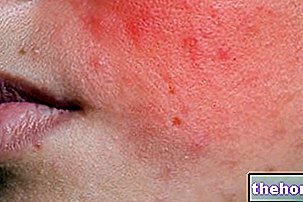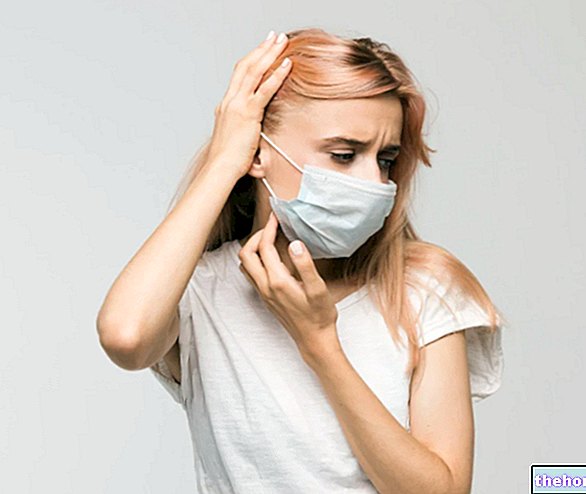Rosacea tends to have a progressive course, so symptoms tend to worsen over time: redness tends to increase until it becomes persistent. If not treated properly, acne rosacea can give rise to skin lesions, swelling of the skin. nose and also affect the region around the eyes (ocular rosacea). For some people, the course of rosacea is cyclical: symptoms may worsen for a limited period of a few weeks or months, then diminish before worsening again.
Rosacea can be confused with other dermatological disorders, such as a skin allergy or eczema. Treatment of the disease can control and reduce the characteristic signs and symptoms of the disease.

The signs that characterize rosacea are of different nature and can manifest themselves with different severity, involving in some cases even the eyes and nose. Often, the area of the skin affected by rosacea may have swelling, warmth and redness. Symptoms tend to be more severe in males, probably because they reach advanced stages of the disorder without undergoing early diagnosis and adequate medical treatment (women, although disadvantaged by the higher incidence of the disease, about three times higher than men, first resort to therapies).
Rosacea presents with several symptoms, among which we can find:
- Redness on the face (or hot flashes): the redness can be sudden or persistent and is localized in the center of the face. The appearance of this symptom can be accompanied by burning and slight swelling.
- Appearance of lesions and papules (small bumps in the skin) or pustules (when the bulges contain pus).
- Rhinophyma: swelling of the nose.
- Teleangestasia: Small blood vessels visible on the nose and cheeks (due to their dilation).
- Skin thickening: Acne rosacea can cause the skin on the forehead, chin, cheeks, or other areas to thicken.
- Irritation and burning sensation in the eyes (ocular rosacea): when the inflammation also affects the eye region and the eyelids. The symptoms affecting the eyes are: redness, dryness, burning, itching, swelling of the eyelids, accentuated sensitivity to light and lacrimation Ocular rosacea affects nearly half of people with rosacea.
- Some symptoms of rosacea can also develop on the neck, chest, scalp and ears.
"US National Rosacea Society" classification
On the basis of the association of these manifestations, four are distinguished subtypes of rosacea:
Erythemato-telangiectatic
Persistent erythema, teleangestasia, itching and burning
Papulo-pustular
Similar to common acne, association of pustules and papules with erythema
Filmy rosacea
Rhinophyma and thickening of the skin of the face
Ocular rosacea
Conjunctivitis, blepharitis, photophobia
Rosacea usually develops in four stages:
- Pre-rosacea: it can start with a tendency to blush easily, and then evolve into a persistent redness in the central part of the face. The redness is the result of the dilation of the blood vessels closest to the surface of the skin.
- Vascular rosacea: Telangestasia can develop as signs and symptoms worsen, small blood vessels appear on the nose and cheeks, visible on the skin (as small red lines). This phase is characterized by the presence of swelling and accentuated sensitivity of the affected area.
- Inflammatory rosacea: Papules (small red bumps) may appear throughout the nose, cheeks, forehead and chin. Pustules (pus-filled patches) may also appear at this stage. Note: The appearance of these two symptoms makes acne rosacea similar to common acne, although the two conditions are totally different and require specific treatments.
- Advanced Rosacea: the disease manifests the previous symptoms more intensely. The redness of the skin and the number of visible blood vessels increase. In this phase, the skin can thicken and cause rhinophyma (the sebaceous glands in the nose and, sometimes, the cheeks swell to cause an accumulation of tissue on and around nose, which appears bulbous.) The latter condition is more common in men and develops slowly over the years.
To consider:
- Due to the progressive course of rosacea, early diagnosis is important and treatments tend to be more effective if started earlier. If left untreated, rosacea tends to get worse over time. In case of persistent redness of the face it would be useful to consult a specialist to undergo an appropriate treatment.
- Many skin care products contain ingredients, such as acids, alcohol, and irritants, which contribute to worsening acne rosacea.
- hot, hot, or spicy foods or drinks;
- alcohol intake;
- extreme temperatures: too cold or too hot;
- exposure to sunlight, wind;
- emotional states: stress, anger or embarrassment;
- excessive exercise;
- hot baths, sauna;
- menopause;
- familiarity;
- microcirculation disorders;
- infections from Helicobacter pylori;
- proliferation of the mite Demodex follicolorum (present for connective tissue changes that create a favorable environment for its reproduction);
- prolonged use of corticosteroids and drugs that dilate blood vessels (to control blood pressure).
Rosacea and microcirculation disorders.
Acne rosacea is primarily a vascular disorder: early disorders are the typical redness, due to alterations in venous flows; the first lesions in the skin are pathological dilations of the blood capillaries.
Acne rosacea and Helicobacter pylori infection.
There is a relationship between positive Hp gastric ulcer and rosacea: the metabolism of the bacterium is able to release nitrates that induce the formation of nitric oxide, a powerful vasodilator. Following the systemic antibiotic treatment of Helicobacter pylori infection (and its consequent eradication) it is possible to report an improvement in the symptoms of rosacea, especially at the ocular level.









.jpg)


















